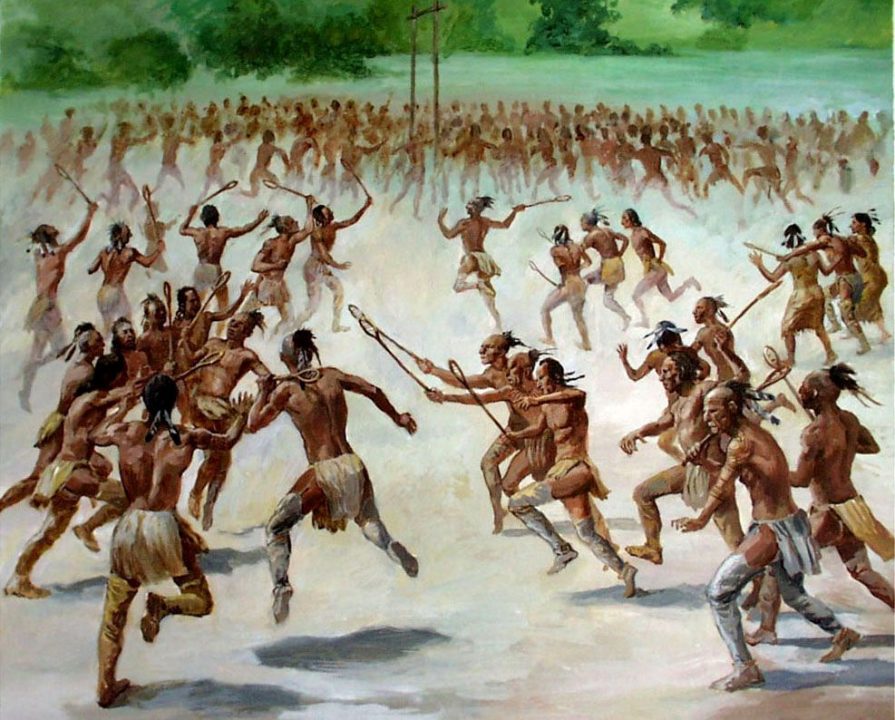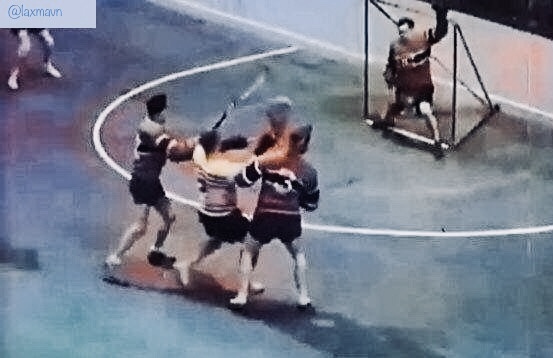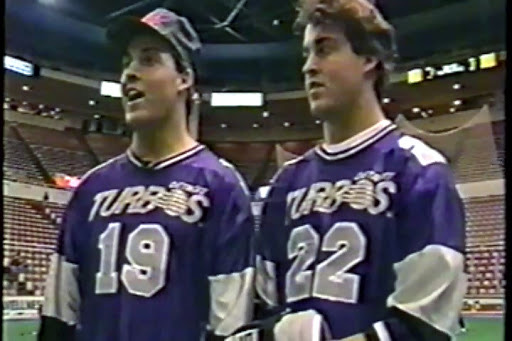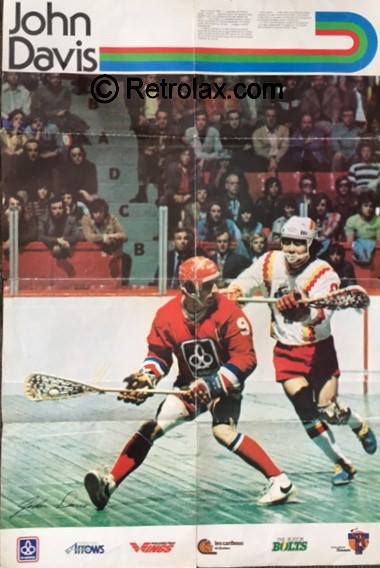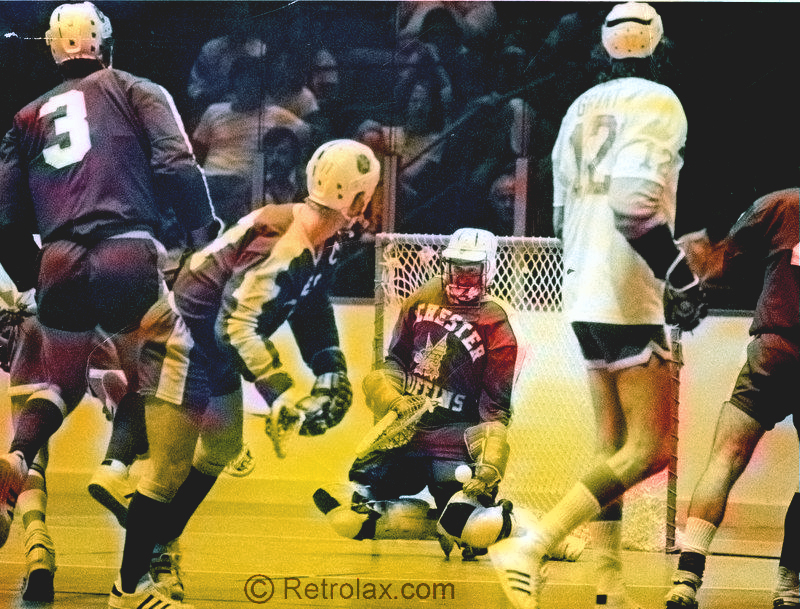BY PRIIT J. VESILIND
The Iroquois revere lacrosse as the game of The Creator, but the indoor version of their ancient sport is rougher than the devil
In 1933, the year box lacrosse and the Red Devils came to Syracuse, Oren Lyons, the goalkeeper, danced the Charleston on a three-inch beam 100 feet above the floor of the Crucible Steel plant. Just for the hell of it.
“He was a good dancer, see?” explains his buddy and teammate, Buffalo Pierce. “And he had a lot of nerve. You gotta have nerve to work the high iron. I guess Indians are born that way.”
When Oren Lyons died in a car wreck in 1954, his goalkeeper’s stick was laid in the casket beside him, as is the custom, and during the all-night vigil in the Long House of the Onondagas, his teammates surrounded the casket with their own sticks in his honor. In the 500-year history of the Iroquois nations, lacrosse had always been the game of The Creator, Soo-Gui-Ya-Di-Sa-A, and he had always promised his people they would always have it—even in life after death.
Six miles south of downtown Syracuse, past Booher’s Lumber Company and the Nedrow Drive-In, the houses run out of paint, some streets still get along on dirt and gravel, and makeshift lacrosse goals of plywood and chicken wire sit beside the sheds. It is the Onondagas’ Nedrow reservation. There is a broadleaf forest there where boys will chase coons in the uppermost branches; there are country roads where hickory leaves cast mottled shadows that cool the dust; and, on summer evenings, there is the smell of roast corn on the cob.

“Indian kids used to get up in the morning and come home at night,” old-timer Irving Powless remembers. “No telling where they’d been. We were out in the woods all day, daring each other to do all kinds of crazy stunts. It seemed natural to go up into the high iron, I guess. I did it just to prove I could. And, besides, it was good money.”
By the time an Iroquois boy is 18, it is practically routine that he is a lacrosse player, an iron worker and sometimes a hard drinker. In the perspective of the reservation, each is somewhat admirable, for the young man is the warrior of the Onondagas in a time where there are no more battles.
Buffalo Pierce sits at the reservation lacrosse box complacently these days, quite pleased with being a legendary figure. Once or twice a week he goes up to the Syracuse War Memorial Coliseum, where the Warriors play box lacrosse. The crowds run close to 3,000 people, including a large number of boisterous Indian fans. The Warriors are part of the first successful box lacrosse league since the Red Devils folded. The North American Lacrosse Association, a predominantly Indian league straddling the Canadian border, is composed of eight amateur teams.
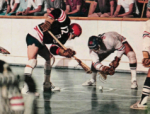
Like the Red Devils, they play lacrosse in a hockey rink without the ice, a game devised by some clever Canadians to accommodate all those empty rinks during the summers. It is comparable to nailing up a pair of basketball hoops in a handball court, inviting the Russians and throwing away the whistle. Its rules draw about evenly from ice hockey, field lacrosse and what used to be called “murder ball” on grammar school playgrounds (whoever got the ball ran like fury before he got murdered).
Until one white player joined them this year, the Warriors were the only team composed entirely of Indians. They are also the most successful team in the league. Head Coach Lou Jacques, who manufactures lacrosse sticks on the reservation, says he has invited white players from the local colleges, but they won’t come.
“The whites think it’s too rough,” he says. “They call it organized manslaughter.” Some of the Onondagas who have been on the high iron put it more bluntly. They say the white man can’t hack it.
It is a savage whiplash of a game. Teams are trimmed to six players, with sticks and goals shortened and the passing tightened. Like hockey, it moves with no time-outs and no out-of-bounds, a demolition derby of nose dives on concrete and suicidal, full-court charges through a gauntlet. The flow of blood would have delighted Attila the Hun.
In Canada a pyramid of “boxla” leagues, from pee-wee to pros, developed rapidly, but the hub of American lacrosse was in Maryland, an area generally lacking in empty hockey rinks. The new game was dismissed as a novelty—the pitch-and-putt of lacrosse. Only the Iroquois Indians of upstate New York embraced it when it came south in the early 1920s. They sensed that the spirit and free style of the box game was closer to the lacrosse of their ancestors, when the goals, ironically, were sometimes set as much as a mile apart, and hundreds of warriors scrapped over the roll of hard leather in training for battle. Occasionally the game served as the battle itself, a lesson in civilization their white conquerors never learned.
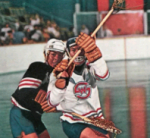
Box lacrosse was supposed to revolutionize spectator sport in Syracuse when it came off the reservation in 1933. It was the inspiration of Robert F. Kenefick, fast-talking promoter and sports editor of the Syracuse Journal—and it folded in two years. To round up a team, Kenefick advertised in his newspaper for players, expecting 20 or 30 whites from the local schools and 30 or so Indians at the tryouts. What he got was 70 Indians, between the ages of eight and 69 and a single white man. Only half a dozen of the players were promising, so he went recruiting at the St. Regis reservation near Hogansburg, N.Y.
“I rounded up five Mohawks and talked them into coming down to Syracuse with me,” he said. “I put ‘em up in this hotel downtown and took ‘em around the corner to see the strippers. You understand, these mugs were straight out of the woods. I had a call later that night from the hotel to get ‘em out of there. They were tearing the place apart.”
With seven Onondagas from the Nedrow reservation and the five sobered Mohawks, Kenefick announced the formation of the Syracuse Red Devils box lacrosse team. He dressed them in showboat red shorts and jerseys and sewed nickel-head profiles on the front. And he gave them phony names to make believers out of the Syracuse public—“Mad Dog” Gibson, “Big Bear” Goerge and a guy called “Long-Time-No-Sleep,” whose name was sufficient evidence of his ferocity. Oren Lyons was the goalkeeper and Buffalo Pierce the star. Kenefick never bothered to rename Pierce, who earned his nickname in football as a running back for the semipro Oakwood Knights. Anyway, Buffalo’s mother called him Stanley.
“Nobody cared much about the publicity,” Buffalo says. “We got 10 bucks a game and I supported my family with that, plus my football money. In those days you’d do anything for a buck.”
One must suppose that Syracusans found better ways to spend their bucks than watching a bunch of Indians beat each other over the head. The Red Devils went the way of the Charleston, and box lacrosse buried itself once more on the reservation.
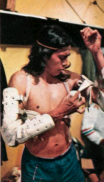
It was not until 1969 that the Indians themselves came up with the North American Lacrosse Association. It now includes the Syracuse Warriors, the Six Nations from Ontario, Senecas from Newtown, N.Y., Mohawks from St. Regis as well as teams from Morrisburg, Ontario, Akron, N.Y., Niagara Falls, N.Y., and Caughnawaga near Montreal.
Efforts to establish a professional circuit, a standing goal since the demise of the Red Devils, failed again this spring. Kenefick had a variety of excuses—the white population could not identify with an all-Indian team; nobody wanted to watch a game indoors during the summer; nobody really understood the sport. Warrior Coach Lou Jacques blames it simply on a lack of financial backing. The league is held together only through the willingness of the players. The season lasts from May to September, with games twice a week—a lot of time and pain for no pay.
Oliver Hill, a 30-year old Onondagan and president of the NALA since 1970, used to climb up and down extra steel columns while at work to keep in shape for lacrosse. There was never enough time to just plain work out. Construction paid. Lacrosse did not.
“With us, a lot of pride enters into this game,” he says. “Many people think we’re semipros or something because we charge admission. They don’t understand where the money goes, they think we get it ourselves. Heck, they don’t have to pay me. They don’t even have to give me a ride. It’s been so instilled in me, I’d play if I had to run to Montreal.”
The return of big-time box lacrosse has been good for the reservation, and has done much to bring the Indian community closer to the city. For the first time, after four years of self-management and promotion, the Syracuse Warriors are sponsored by a group of non-Indian businessmen who are guaranteeing the reservation a profit of $5,000 for the season. The money is administered by the Onondaga Athletic Club, which in three years has furnished the reservation with a blacktop basketball court, $1,000 worth of playground equipment, funds toward an Olympic-sized swimming pool, a new firehouse, and support for various reservation teams from pee-wee lacrosse to broomball.
Instead of the old cycle of iron work, reservation lacrosse, beer busts and the gradual erosion of Indian culture, there is increasing talk of education, of coming back to the reservation and teaching, of pride in being an Indian.
“It’s been only in the past five or 10 years,” Lou Jacques says with some trace of sadness, “that colleges and even high schools around here have really accepted our boys as lacrosse players.”
Oliver Hill, aided by a federal grant, enrolled at Syracuse University last year because he wanted to do something more with his life than work on the iron. This spring he was the leading scorer on the Syracuse field lacrosse team. And Lee Lyons, 42-year-old son of the Red Devil goalkeeper, is a whole story in himself. He is at Syracuse after retirement from the U.S. Army, and he played freshman lacrosse. “No trouble with the legs,” he says.
Ron Doctor, who captained the Syracuse team two years ago, is back as the assistant to the university’s coach, Roy Simmons, Jr., and Oliver’s cousin, Ron Hill, has mystified opposing coaches with his stick handling. It became almost routine, Simmons claims, for them to halt the game and ask for a stick check after Ron had coaxed the ball through some unlikely maneuver. But Hill’s stick was always ordinary—just a product of years in the Nedrow box.
Oren Lyons, Jr., the oldest son, followed his father as a goalkeeper and became an All-America at Syracuse in the 1950s. Now a successful commercial artist and a university lecturer with a master’s degree, he is one of 14 chiefs of the Onondaga nation.
“You have to understand how important games are to the Indian,” he said one afternoon at his reservation home. “And lacrosse—well, lacrosse is the game of the Creator. Anthropologists come here, stay for a year and think they understand our life and our religion. If you can’t understand the language, you never really get it right. I’ve been here all my life and I’m still learning. But when I die, I know I’ll be buried with my goalkeeper’s stick.”

Most of the whites who come to War Memorial Coliseum to watch the Warriors play their quick, violent game have little notion of the Indians’ feeling for it. There is no cultural equivalent. Even fewer of them know what happens behind the door of the locker room minutes before the Warriors are introduced.
An elder of the Onondagas, one who can communicate with the Creator, calls for silence then crumples a sheet of newspaper into a ball and lights it. As the flames rise between the rows of metal lockers he takes tobacco from a small leather pouch and sprinkles it into the fire. In a pinched monotone, he asks the god of the Long House to bless the game and protect the players from injury. The warriors in their armor, the Hou-Chi-Qwa-Is, gather around the flame and its acrid smoke and murmur their response in the language of their nation.
Among them are teachers, mechanics and artists, as well as the men who work the high iron. Twice a week in the summer, for three periods of 20 minutes each, they share a tradition that binds them into a camaraderie of spirit that spans time, distance and nations.
(from Sports Illustrated, September 3, 1973)

